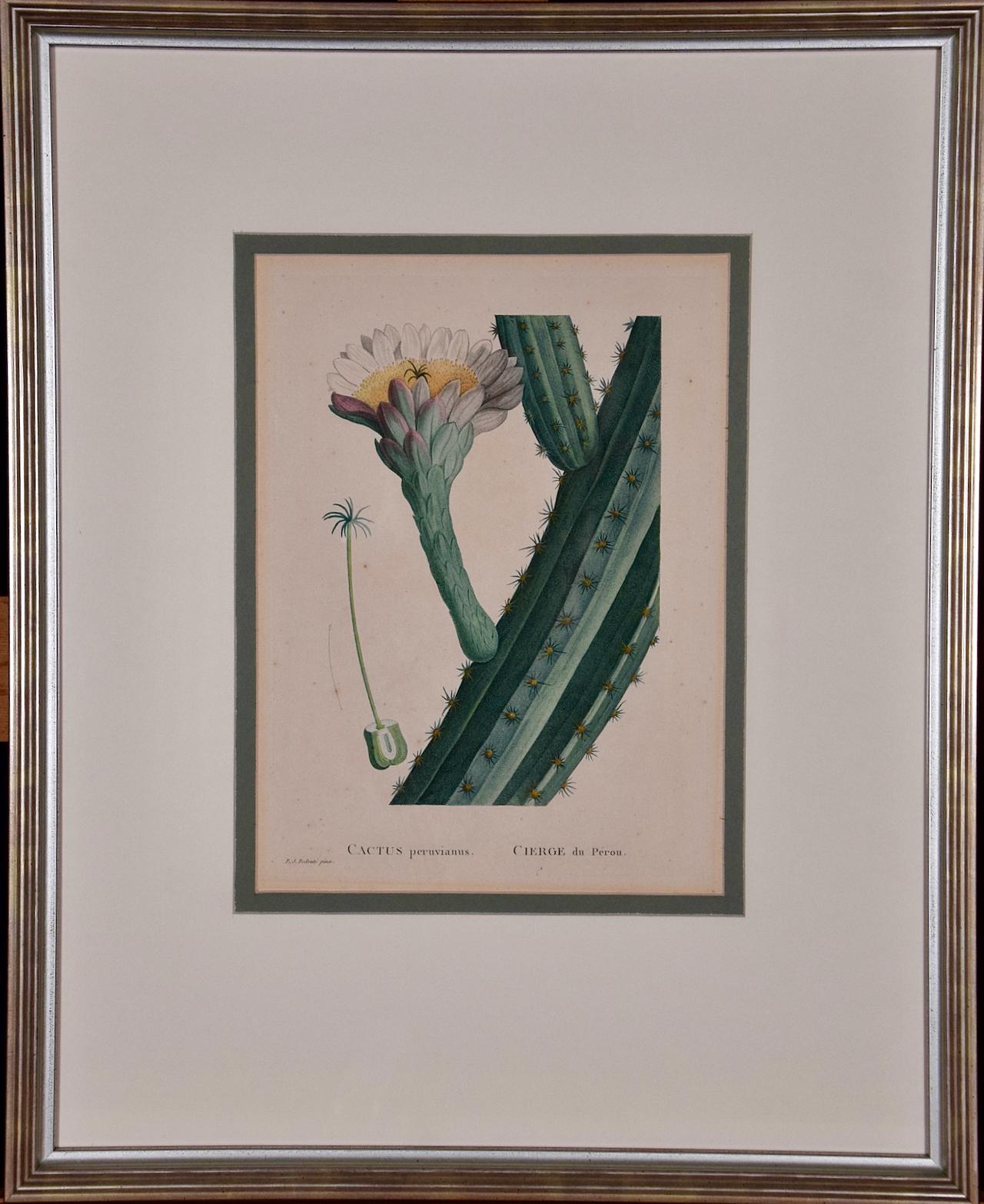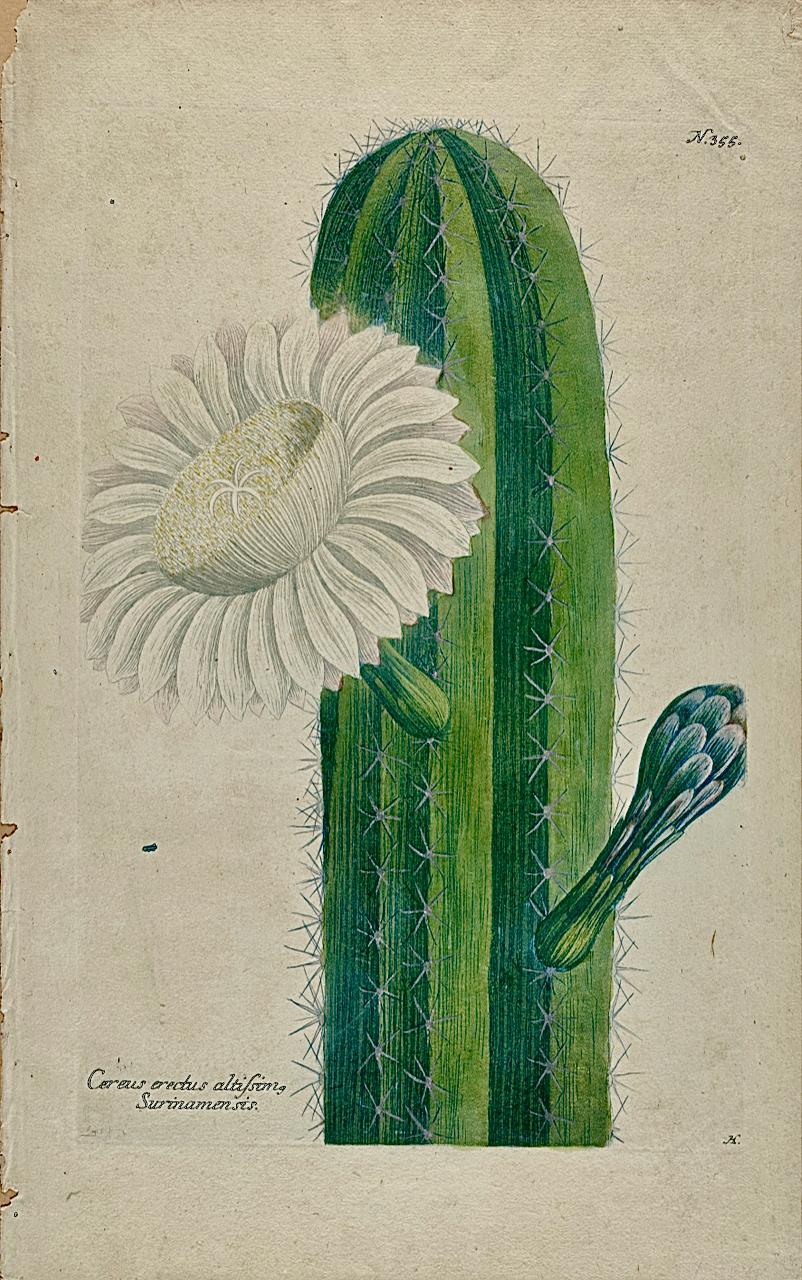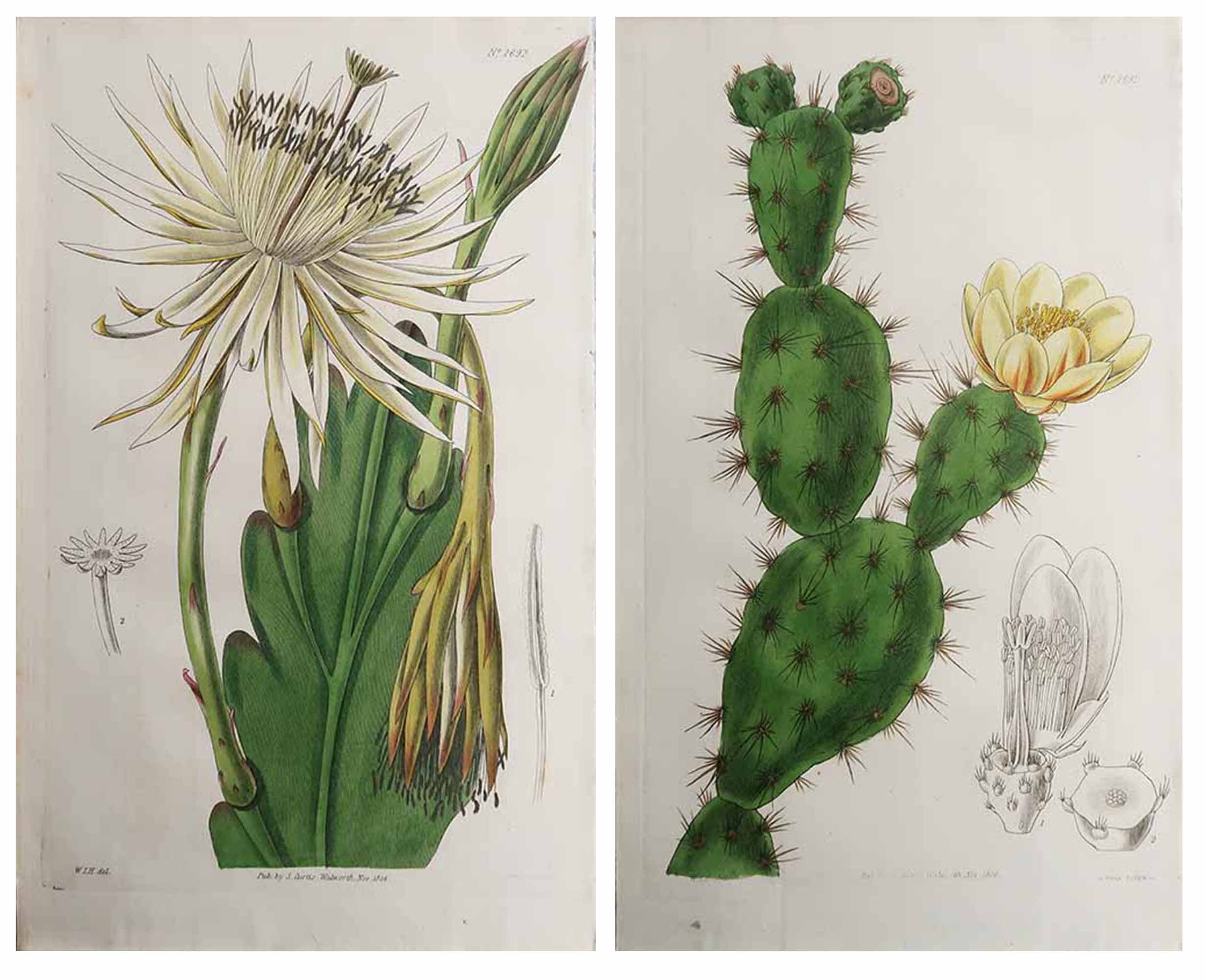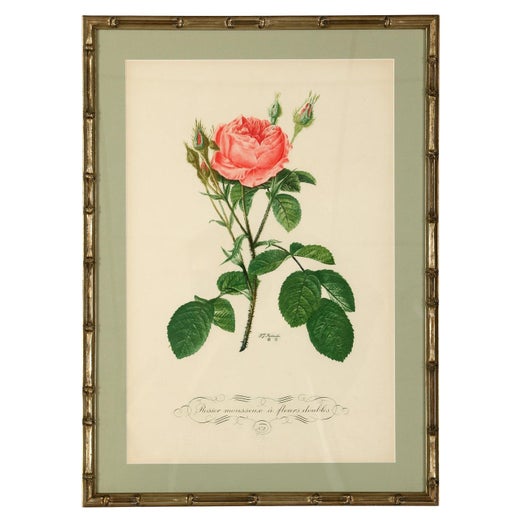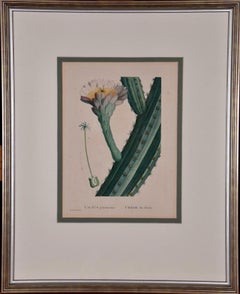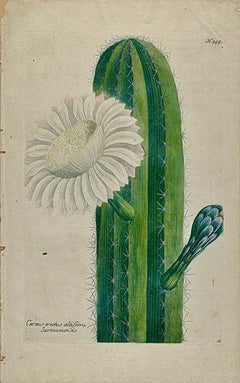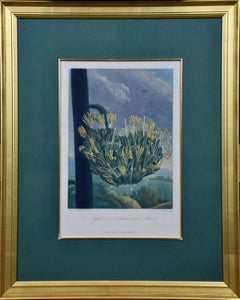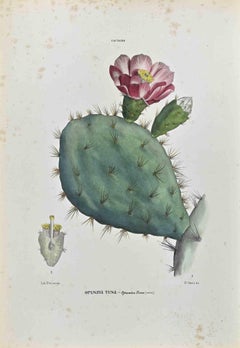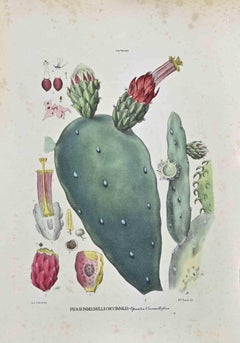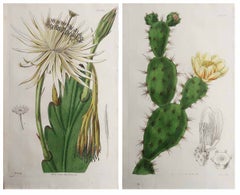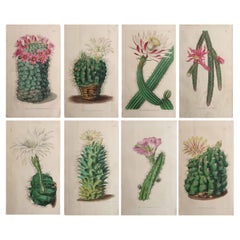Items Similar to Flowering Prickly Pear Cactus: Framed 18th C. Hand-colored Engraving by Redoute
Want more images or videos?
Request additional images or videos from the seller
1 of 10
Pierre-Joseph RedoutéFlowering Prickly Pear Cactus: Framed 18th C. Hand-colored Engraving by Redoute1799
1799
$2,060
$2,57520% Off
£1,596.32
£1,995.3920% Off
€1,811.49
€2,264.3720% Off
CA$2,952.51
CA$3,690.6420% Off
A$3,242.44
A$4,053.0520% Off
CHF 1,669.08
CHF 2,086.3620% Off
MX$38,796.74
MX$48,495.9220% Off
NOK 21,251.12
NOK 26,563.9020% Off
SEK 19,915.46
SEK 24,894.3320% Off
DKK 13,528.96
DKK 16,911.2120% Off
About the Item
This is a hand-colored stipple engraving entitled "Cactus Opuntia Polyanthos, Cierge Raquette Multiflore" (Prickly Pear Cactus) by Pierre-Joseph Redouté, Plate 59 from his illustrated publication 'Plantarum Historia Succulentarum ou Histoire des Plantes Grasses', published in Paris in 1799. Redoute was a pioneer of the stipple engraving technique, which he used to create this image. It involves utilizing a series of small dots worked into a copper plate rather than the more common lines. These dots can be made smaller or thicker depending on the degree of opacity the artist intends for various areas of the print. When inked and applied to paper, this allows for a greater portion of the paper to be seen, which accentuates the appearance of luminosity of the subject the artist is creating. Different color inks are used in the printing process, a time consuming technique known as "a la poupee". The engraving is then finished with watercolor to further enhance the beauty and realism of the print subject.
This engraving of a flowering cactus is presented in a double mat; white outer mat and heather green inner mat.The mat measures 20" x 16" and the sheet measures 19.5" x 13.38". There are wide margins with a few short tears and chips along the the right and upper edges, which are all covered by the mat. There are small spots predominantly in the margins, but a few are present in the image area, but the print is otherwise in very good condition. There is another Redoute flowering cactus listed on 1stdibs, LU117326854582. The pair would make an attractive display grouping.
Pierre-Joseph Redouté (1759-1840), was a painter and botanist originally from Belgium, who pursued his extremely successful artistic career in France. He is well known for his watercolor paintings of roses, lilies and other flowers and their subsequent folio-sized, color stipple engravings. Some believe him to be the greatest botanical illustrator of all time. Redouté was a favorite of the French royal court at the time and of the post French revolution aristocracy. He was an official court artist of Queen Marie Antoinette and his works continued to in demand during and after the French Revolution and Reign of Terror. He combined great artistic skills with a pleasing, ingratiating personality which assisted him with his influential patrons. After the fall of the French monarchy, he was a favorite Empress Joséphine, Napoleon Bonaparte's wife and later by his second wife Marie Louise, Duchess of Parma. The wife of Louis Philippe I, the last king of France, Maria Amalia of Naples and Sicily, was also a patron.
- Creator:Pierre-Joseph Redouté (1759 - 1840, French)
- Creation Year:1799
- Dimensions:Height: 21.25 in (53.98 cm)Width: 17.25 in (43.82 cm)Depth: 1.13 in (2.88 cm)
- Medium:
- Movement & Style:
- Period:
- Framing:Framing Options Available
- Condition:
- Gallery Location:Alamo, CA
- Reference Number:Seller: # 33601stDibs: LU117326853392
Pierre-Joseph Redouté
Pierre-Joseph Redouté (1759-1840), was a painter and botanist originally from Belgium, who pursued his extremely successful artistic career in France. He is well known for his watercolor paintings of roses, lilies and other flowers and their subsequent folio-sized, color stipple engravings. Some believe him to be the greatest botanical illustrator of all time. Redouté was a favorite of the French royal court at the time and of the post French revolution aristocracy. He was an official court artist of Queen Marie Antoinette and his works continued to in demand during and after the French Revolution and Reign of Terror. He combined great artistic skills with a pleasing, ingratiating personality which assisted him with his influential patrons. After the fall of the French monarchy, he was a favorite Empress Joséphine, Napoleon Bonaparte's wife and later by his second wife Marie Louise, Duchess of Parma. The wife of Louis Philippe I, the last king of France, Maria Amalia of Naples and Sicily, was also a patron.
About the Seller
5.0
Platinum Seller
Premium sellers with a 4.7+ rating and 24-hour response times
Established in 2011
1stDibs seller since 2019
295 sales on 1stDibs
Typical response time: 1 hour
- ShippingRetrieving quote...Shipping from: Alamo, CA
- Return Policy
More From This Seller
View AllFlowering Cactus: A Framed 18th C. Hand-colored Engraving by Redoute
By Pierre-Joseph Redouté
Located in Alamo, CA
This framed hand-colored stipple engraving entitled "Cactus Peruvianus Cierge du Pérou" by Pierre-Joseph Redouté, Plate 58 from his illustrated publication 'Plantarum Historia Succulentarum ou Histoire des Plantes Grasses', published in Paris in 1799. It depicts a branching limb of a cactus with a beautiful flower. There is a separate detail of the anatomy of a seed with early growth. Redoute was a pioneer of the stipple engraving technique, which he used to create this image. It involves utilizing a series of small dots worked into a copper plate rather than the more common lines. These dots can be made smaller or thicker depending on the degree of opacity the artist intends for various areas of the print. When inked and applied to paper, this allows for a greater portion of the paper to be seen, which accentuates the appearance of luminosity of the subject the artist is creating. Different color inks are used in the printing process, a time consuming technique known as "a la poupee". The engraving is then finished with watercolor to further enhance the beauty and realism of the print subject.
This engraving of a flowering cactus is presented in silver-colored ribbed wood frame and a double mat; cream-colored outer mat and heather green inner mat. The frame measures 21.25" high by 17.25" wide by 1.13" deep. The sheet measures 19.88" high by 14" wide. There are wide margins with a few short tears and chips along the the left, right and upper edges, which are all covered by the mat. There are small spots predominantly in the margins, with a few present in the image area. The print is otherwise in very good condition. There is another Redoute flowering cactus listed on 1stdibs, LU117326853392, which is framed and matted identically to this one. The pair would make an attractive display grouping.
Pierre-Joseph Redouté (1759-1840), was a painter and botanist originally from Belgium, who pursued his extremely successful artistic career in France. He is well known for his watercolor paintings of roses, lilies and other flowers and their subsequent folio-sized, color stipple engravings. Some believe him to be the greatest botanical illustrator of all time. Redouté was a favorite of the French royal court at the time and of the post French...
Category
Late 18th Century Naturalistic Still-life Prints
Materials
Engraving
A Flowering Cactus Plant: 18th C. Hand-colored Botanical Engraving by Weinmann
By Johann Wilhelm Weinmann
Located in Alamo, CA
This hand-colored botanical mezzotint and line engraving by Johann Wilhelm Weinmann (1683-1741) is entitled "Cereus Erectus Altissimo Surinamensis (Cereus Cactus Plant)". It is plate...
Category
Mid-18th Century Naturalistic Still-life Prints
Materials
Engraving, Mezzotint
Cactus & Rose of Jericho Plants: A Besler Hand-colored Botanical Engraving
Located in Alamo, CA
A hand-colored copper plate engraving depicting flowering "Melocactos" (Turk's Cap Cactus or Mother-in-law's Cushion), "Rosa Hiericontea aperta" (Rose of Jericho Unfolded), "Rosa Hie...
Category
Early 18th Century Academic Still-life Prints
Materials
Engraving
Agave or American Aloe: A Framed Hand-colored Engraving from Robert Thornton
By Dr. Robert John Thornton
Located in Alamo, CA
This is a framed hand-colored botanical engraving entitled "Agave or American Aloe" by Reinagle for Robert Thornton's publication 'The Temple of Flora, or Garden of the Botanist, Poet, Painter and Philosopher', published in London in 1811. This beautiful botanical was created using several engraving techniques, including aquatint, mezzotint, stipple and line engraving methods. It was printed in color and then finished by hand.
The print is presented in a gold-colored wood frame and a heather green mat, which is enhanced with a gold fillet. The frame measures 21.63" high by 16.63" wide and 1" deep. It is glazed with UV conservation glass. All of the mounting materials are archival. The original text page from the early 19th century publication is attached to the rear of the frame. The print is in excellent condition.
Robert John Thornton (1765-1832) was attracted to natural history at an early edge and created his own botanical garden and an aviary as a boy. He graduated from Cambridge with a medical degree and set up practice as a London. He inherited his family fortune in 1797, which allowed Thornton the opportunity to devote time to his lifelong goal of creating an extensive scholarly work dedicated to the great classical Swedish naturalist, Carolus Von Linnaeus (1707-1778), also known as Carl von Linné...
Category
Early 19th Century Still-life Prints
Materials
Engraving, Mezzotint
Flowering Spurge: 18th Century Hand-colored Botanical Engraving by J. Weinmann
By Johann Wilhelm Weinmann
Located in Alamo, CA
This hand-colored botanical mezzotint and line engraving by Johann Wilhelm Weinmann (1683-1741) is entitled "A. Esula seu Tithyinalus Africanus SpinosusCera Effigie, B. Esula seu Ti...
Category
Mid-18th Century Naturalistic Still-life Prints
Materials
Engraving, Mezzotint
Flowering Air Plant: A 19th Century Hand-colored Engraving by William Curtis
By William Curtis
Located in Alamo, CA
This early 19th century hand-colored double fold-out botanical engraving is entitled "Pendulous-flowered Bryophyllum", plate 1409, published in London in 1809 in William Curtis’s 'The Botanical Magazine, or Flower-Garden Displayed'. Bryophyllum pinnatum, also known as the air plant...
Category
Early 1800s Naturalistic Still-life Prints
Materials
Engraving
You May Also Like
The Cactaceae - Lithograph by Vincenzo Tenore - 1870s
Located in Roma, IT
Lithograph hand watercolored.
Plate from "Atlante di Botanica popolare ossia Illustrazione di Piante Notevoli di ogni famiglia" (Atlas of popular botany or illustration of notable p...
Category
1870s Modern Figurative Prints
Materials
Lithograph
The Cactaceae - Lithograph by Vincenzo Tenore - 1870s
Located in Roma, IT
Lithograph hand watercolored.
Plate from "Atlante di Botanica popolare ossia Illustrazione di Piante Notevoli di ogni famiglia" (Atlas of popular botany or illustration of notable p...
Category
1870s Modern Figurative Prints
Materials
Lithograph
Pair of Original Antique Botanical Prints- Cactus. Dated 1826
Located in St Annes, Lancashire
Wonderful pair of cactus prints.
Lithographs
Original hand color
Published by S.Curtis. Dated 1826
Unframed.
Category
Antique 1820s English Georgian Prints
Materials
Paper
Set of 8 Original Antique Botanical Prints- Cactus. Dated 1837
Located in St Annes, Lancashire
Wonderful set of 8 cactus prints.
Lithographs after drawings by W.Fitch
Original hand color
Published by Curtis. Dated 1837 and 1838
Unframed.
Category
Antique 1830s English Georgian Prints
Materials
Paper
The Cacti - Lithograph by Vincenzo Tenore - 1870s
Located in Roma, IT
Lithograph hand watercolored.
Plate from "Atlante di Botanica popolare ossia Illustrazione di Piante Notevoli di ogni famiglia" (Atlas of popular botany or illustration of notable ...
Category
19th Century Modern Figurative Prints
Materials
Lithograph
Flowering Cactus Engraving
By Johann Wilhelm Weinmann
Located in New York, NY
Original engraving by Johann Wilhelm Weinmann from "Phytanthosa Iconographia." Ratisbon, 1737-1745.
This plate: Cereus Minimus Serpens Americanus. [Cactus].
Mezzotint engraving print...
Category
Early 18th Century Prints and Multiples
Materials
Laid Paper
More Ways To Browse
Antique Duchess
18th Century Colored Engraving
Prickly Pear
Santa Fe Bronze
Sculpture Cake
Sculpture Pop Art Candy
Smith Brothers
Spanish Woman Oil Paintings
Stick Bug
Tom Young
Used Blimps
Used Dog Sleds
Vampire Art
Vanguard Oil Paintings
Vintage Bed Sheets
Vintage Running Posters
William Morris Art
Wood Cube Sculpture
